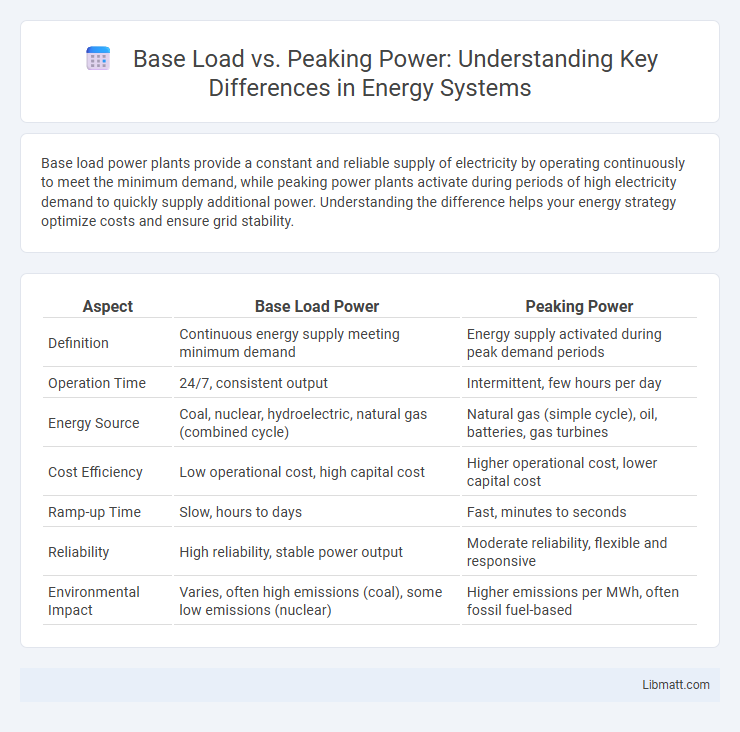Base load power plants provide a constant and reliable supply of electricity by operating continuously to meet the minimum demand, while peaking power plants activate during periods of high electricity demand to quickly supply additional power. Understanding the difference helps your energy strategy optimize costs and ensure grid stability.
Table of Comparison
| Aspect | Base Load Power | Peaking Power |
|---|---|---|
| Definition | Continuous energy supply meeting minimum demand | Energy supply activated during peak demand periods |
| Operation Time | 24/7, consistent output | Intermittent, few hours per day |
| Energy Source | Coal, nuclear, hydroelectric, natural gas (combined cycle) | Natural gas (simple cycle), oil, batteries, gas turbines |
| Cost Efficiency | Low operational cost, high capital cost | Higher operational cost, lower capital cost |
| Ramp-up Time | Slow, hours to days | Fast, minutes to seconds |
| Reliability | High reliability, stable power output | Moderate reliability, flexible and responsive |
| Environmental Impact | Varies, often high emissions (coal), some low emissions (nuclear) | Higher emissions per MWh, often fossil fuel-based |
Introduction to Base Load and Peaking Power
Base load power refers to the consistent and reliable energy supply needed to meet the minimum continuous demand on the electricity grid, often provided by coal, nuclear, or hydro plants. Peaking power serves as a supplementary energy source activated during periods of high demand, typically generated by fast-start natural gas turbines or energy storage systems. Understanding the roles of base load and peaking power helps optimize your energy management strategy for efficiency and cost-effectiveness.
Defining Base Load Power
Base load power refers to the minimum continuous level of electricity demand that must be met 24/7 to ensure grid stability. Power plants such as coal, nuclear, and large hydro facilities typically provide base load power due to their ability to operate efficiently and reliably over long periods. Understanding your base load power requirements helps optimize energy generation and ensures a steady supply without interruptions.
Understanding Peaking Power
Peaking power plants operate during times of highest electricity demand to stabilize the grid and prevent outages. These plants typically use fast-start technologies like gas turbines, enabling rapid ramp-up to meet sudden load spikes. Their role complements base load power plants, which provide continuous, steady electricity output for everyday consumption.
Key Differences Between Base Load and Peaking Power
Base load power plants operate continuously to meet the minimum electricity demand and are typically powered by coal, nuclear, or hydroelectric energy sources due to their efficiency and reliability. Peaking power plants run only during periods of high electricity demand and often use natural gas turbines or diesel generators for quick startup and flexibility. The primary difference lies in their operational role: base load plants provide constant, stable energy output, whereas peaking plants address short-term spikes in electricity consumption.
Typical Sources of Base Load Power
Typical sources of base load power include coal-fired power plants, nuclear reactors, and large-scale hydroelectric facilities, which provide consistent and reliable electricity output to meet the minimum demand. Natural gas combined-cycle plants also contribute to base load generation due to their operational flexibility and relatively lower emissions. These power sources are essential for maintaining grid stability by continuously supplying energy regardless of fluctuations in demand.
Common Sources of Peaking Power
Common sources of peaking power include natural gas turbines, diesel generators, and hydroelectric plants, known for their rapid start-up capabilities to meet sudden demand spikes. These energy sources provide flexibility and reliability, filling the gap when base load power plants, like coal or nuclear, operate at steady output levels. Your energy strategy benefits from peaking power by ensuring grid stability during peak consumption periods.
Role in Grid Stability and Reliability
Base load power plants provide continuous, steady electricity essential for maintaining grid stability by meeting minimum consistent demand, ensuring reliable voltage and frequency levels. Peaking power plants quickly ramp up production during periods of high electricity demand, preventing blackouts and supporting grid reliability during peak load fluctuations. The synergy between base load and peaking power sources optimizes overall grid performance, balancing efficiency with responsiveness.
Cost Implications and Economic Considerations
Base load power plants operate continuously to meet the minimum demand, offering lower operating costs due to high efficiency and stable fuel consumption. Peaking power plants incur higher costs per unit of electricity because they run intermittently and often rely on expensive fuels like natural gas or diesel for rapid start-up. Your energy strategy should balance these economic factors by leveraging base load capacity for affordability while using peaking plants to manage demand spikes and ensure grid reliability.
Impact on Renewable Integration
Base load power plants provide consistent, stable electricity essential for grid reliability, supporting the integration of intermittent renewable sources like solar and wind by balancing their variability. Peaking power plants, often fueled by natural gas, activate during demand spikes to complement renewable energy fluctuations, ensuring grid stability despite renewable generation unpredictability. Effective coordination between base load and peaking power enhances renewable penetration by mitigating supply-demand mismatches and reducing curtailment of clean energy.
Future Trends in Electricity Generation
Future trends in electricity generation emphasize the integration of renewable energy sources, which challenges traditional base load power plants due to their inflexibility. Peaking power plants, often using natural gas or battery storage, are becoming essential for balancing grid fluctuations caused by intermittent solar and wind energy. Advances in smart grid technology and energy storage systems will further optimize the deployment of base load and peaking power to enhance grid reliability and reduce carbon emissions.
Base Load vs Peaking Power Infographic

 libmatt.com
libmatt.com